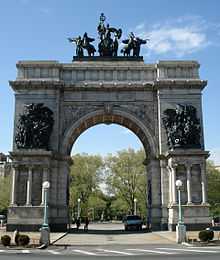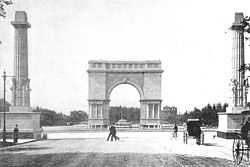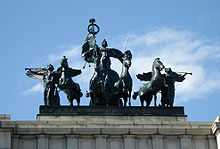Soldiers' and Sailors' Arch
| Soldiers' and Sailors' Arch[1] (Soldiers' and Sailors' Monument[2]) | |
| American Civil War memorial | |
 The triumphal arch at the south end of the traffic oval (foreground). To the left and right of the memorial are additional streets (not shown). | |
| Country | United States |
|---|---|
| State | New York |
| Borough | Brooklyn (New York City) |
| Park | Prospect Park |
| Part of | Grand Army Plaza |
| Nearby structures | 3
|
| Parts | crowning sculpture observation deck on arch W tower w/ Navy & Grant sculptures E tower w/ Army & Lincoln |
| Location | center of walkway under arch |
| - elevation | 140 ft (42.7 m) [3] |
| - coordinates | 40°40′23″N 73°58′11″W / 40.672998°N 73.969842°WCoordinates: 40°40′23″N 73°58′11″W / 40.672998°N 73.969842°W Source: Google Maps url |
| Width | 80 ft (24 m) |
| Height | 80 ft (24 m) |
| - archway | 50 ft (15 m) |
| - top of crowning sculpture | 0 ft (0 m) |
| Depth | 0 ft (0 m) |
| Architect | John H. Duncan[4] |
| Style | Beaux-Arts triumphal arch |
| Dedication | 1892 Oct 21 |
| - Grading, cornerstone | 1889 Jul,[1] 1889 Oct 10 [2] |
| - Sculptures | 1898 Dec 8 (crowning sculpture)[5] 1901 Apr 13 (Navy)[6] |
| - Restored | 1980, 2000 |
The Soldiers' and Sailors' Arch (1889–92)[1] in Brooklyn, New York is a triumphal arch dedicated "To the Defenders of the Union, 1861-1865".[7] The eastern end with a stairway to the observation deck and crowning sculpture is open to the public, while the remainder of the interior is sometimes opened for art shows and performances.
History


An August 6, 1889, William R. Ware and Charles B. Atwood, who had been appointed by the Soldiers' and Sailors' Monument Commission,selected John H. Duncan's design for the arch from 36 designs submitted the previous year.[8] In collaboration with architect Stanford White, Samuel Parsons and Calvert Vaux produced the arch beginning with two and a half months of site preparation; then William Tecumseh Sherman was the speaker at the 1889 cornerstone, and President Grover Cleveland lead the 1892 unveiling.[9]:tbd
The McKim, Mead and White firm recommended the bronze statues for the City Beautiful movement, and park Commissioner Frank Squire engaged Frederick MacMonnies 1894 to design the three bronze sculptural groupings. The interior arch faces have equestrian bas-reliefs of Abraham Lincoln and Ulysses S. Grant sculpted by William Rudolf O'Donovan (men) and Thomas Eakins (horses), that were added in 1895.[9]:723 Also added in 1895 by sculptor Frederick MacMonnies[5] are the Army and Navy sculptures and the allegorical crowning sculpture. This sculpture depicts the winged goddess of victory, following victorious combat (the Civil War) with instruments of war: sword, colors, flagstaff, and quadriga (the Union Army). Winged attendants are seen removing 2 of the 4 quadriga horses for peacetime use (postbellum recovery) while trumpeting the victory and freedom (Emancipation).
The arch was designated a landmark in 1973,[10] and the crowning sculpture was restored after the chariot's figure fell out in 1976.
See also
References
- ↑ 1.0 1.1 1.2 "Grand Army Plaza". Historical Signs Project. nycgovparks.org. 2001-12-14. Retrieved 2011-08-01.
In 1866, the Plaza began to be graded and its interior paved with granite Belgian blocks and, in 1867, the Plaza’s distinctive mounds were built. Subsequent years saw the addition of gas-fueled lamps [and] trolley tracks ... construction of the Soldiers’ and Sailors’ Arch, which began in 1889. ... The Plaza’s four Doric columns were added between 1894 and 1896, the north mound was extended, the other mounds cleared and replanted, and the land around the arch paved with brick. ...statuary was added in this period, including Gouverneur Kemble Warren (1896), Henry Maxwell Tablet [sic] (1903), Alexander J.C. Skene (1905), and Henry Warner Slocum (1906).
- ↑ 2.0 2.1 "Tecumseh's Warm Greeting" (ActivePaper Archive). The Brooklyn Daily Eagle. October 30, 1889. p. 6. Retrieved 2011-08-01.
a silver trowel, bearing the inscription: “Used by General W. T. Sherman, U. S. A., for laying the cornerstone of the Soldiers and Sailors Monument, Brooklyn, N. Y., October 20, 1889.”
- ↑ "X_Value=-73.969842&Y_Value=40.672998". USGS Elevation Web Service Query. United States Geological Survey. Retrieved 2011-06-24.
- ↑ White, Norval; Willensky, Elliot (2000). AIA Guide to New York City (4th ed.). New York Chapter, American Institute of Architects; Crown Publishers/Random House. ISBN 0-8129-3106-8. "Inside the arch itself is more subtle work, bas-reliefs of Lincoln (Thomas Eakins) and Grant (William O' Donovan), both installed in 1895.
- ↑ 5.0 5.1 (December 4, 1898). "Quadriga in its Place" The Brooklyn Daily Eagle Page 31
- ↑ (April 13, 1901). "Navy Group in Place; Arch is Now Complete" The Brooklyn Daily Eagle Page 2
- ↑ Miller, Richard E (November 13, 2008). "Defenders of the Union" (HMdb.org webpage, marker 13548). Retrieved 2011-08-01.
- ↑ The three person Commission was Brooklyn Mayor Alfred C. Chapin, Aldermanic President McCarty, and Grand Army of the Republic Memorial Committee Chairman James D. Bell "Lucky Man: A New Yorker Gets the Soldier's Monument Work". The Brooklyn Daily Eagle (Brooklyn Daily Eagle). 1889-08-06. pp. Page 4, Column 2. Retrieved 2007-01-09.
- ↑ 9.0 9.1 White, Norval; Willensky, Elliot (2000). AIA Guide to New York City (4th ed.). New York Chapter, American Institute of Architects; Crown Publishers/Random House. ISBN 0-8129-3106-8.
Inside the arch itself is more subtle work, bas-reliefs of Lincoln (Thomas Eakins) and Grant (William O' Donovan), both installed in 1895.
:668 - ↑
| Wikimedia Commons has media related to Soldiers' and Sailors' Arch. |